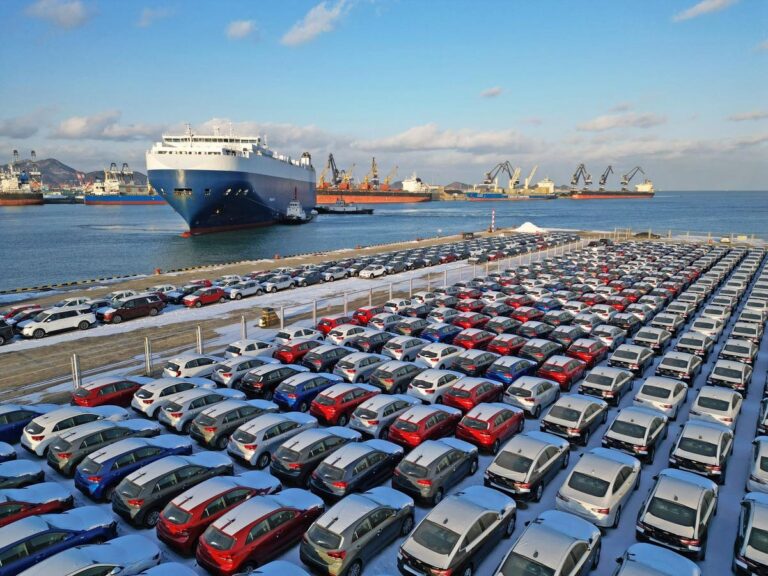Yantai, China
After a nearly five-year hiatus, a new phase of trade tensions with China is underway.
President Biden announced last week that the White House had decided to increase tariffs on a total of $18 billion worth of Chinese imports. This measure applies to some of the fastest growing exports from China. The biggest increase would quadruple the tariff rate on Chinese-made EVs from 25% to 100%, increase the tariff rate on lithium batteries from 7.5% to 25%, and increase the tariff rate on solar panels from 25% to 50%. .
A New York Times article by Keith Bradsher summarizes the steps the Chinese government has taken to spur industrial development since launching its “Made in China 2025” program nearly a decade ago. One way the government subsidizes exports is through the state-owned banking system, which lends to key sectors at low interest rates. According to Germany’s Kiel Institute, nearly all listed companies in China received government subsidies in 2022.
China’s automobile sector recently overtook Japan and Germany to become the world’s largest automobile exporter. It has done this by ramping up EV production, with Chinese companies now producing the majority of the world’s electric vehicle batteries. European car companies feel threatened, with the EU considering raising tariffs on Chinese cars to 55%. The Biden administration is pushing for the production of American-made EVs and wants to protect them at this stage of development.
Until now, Biden had maintained most of the Trump administration’s tariffs on China, but he did not add any new items. With less than six months until the presidential election, and with President Trump making international trade one of the highlights of his campaign, Biden wants to take a tough stance on China.
Steve Ratner criticized Biden’s move in a New York Times op-ed.
new york times
When President Trump launched a trade war in early 2018, investors were wary of prompting China to retaliate and threaten the global economy. The S&P 500 rose steadily in 2017 in anticipation of President Trump’s tax cuts, but experienced a roughly 15% decline in 2018 as trade tensions escalated (see chart below).
S&P 500 Index, January 2017 to January 2020
index
The stock market did not surpass its previous high until mid-2019, when the United States and China struck an agreement in which China would expand its purchases of American goods and services by $200 billion over two years. But China has not kept its promise, which may be why President Trump is now doubling down on pressure on China.
Stock markets have not reacted to Biden’s announcement because the tariffs he would impose on China would be more targeted than those being considered by Trump. During the current campaign, President Trump has advocated for a 60% increase in tariffs on China and at least a 10% increase in tariffs on all $3 trillion worth of U.S. imports. He recently called for a 200% tariff on cars made by Chinese companies in Mexico.
A report from the Peterson Institute for International Economics (PIIE) argues that President Trump’s unprecedented trade proposals will cause “significant collateral damage to the U.S. economy.” They estimate it costs U.S. consumers at least $500 billion a year, and increases costs for middle-income households by at least $1,700 a year. The move is likely to invite retaliation not only from China but also from trading partners such as Europe, Canada and Mexico, further increasing costs.
Moody’s Mark Zandi has also been highly critical of Trump’s trade proposals. He estimates that even if Trump were to soften the blow of the tariff hikes with tax cuts, the U.S. economy would lose 675,000 jobs, inflation would rise, and GDP would shrink by 0.6 percentage points. Given the possibility of retaliation, he believes the U.S. economy would fall into recession.
So how should investors respond to this outlook?
My view is that they shouldn’t overreact because it’s at stake whether President Trump will be elected president, and if he is, whether his actions will match his rhetoric. It is something. That said, one lesson from Trump’s presidency is that his stance on international trade should not be ignored. President Trump has been a staunch critic of free trade for the past 40 years.
When Trump took office in 2017, one of his most important decisions was to appoint Robert Lighthizer as U.S. Trade Representative. He served as acting trade representative in the Ronald Reagan administration in 1985, at a time when the U.S. dollar was extremely strong and the United States was running a record trade deficit with Japan. At the time, he was involved in negotiations over restrictions on Japanese automobile exports to the United States.
In Lighthizer’s capacity as the Trump administration’s trade envoy, the administration’s top goal was to restore lost manufacturing jobs. China was a primary target, with many saying it benefited unfairly when it joined the World Trade Organization in 2001 and U.S. manufacturing jobs fell by about 6 million people over 10 years. The observer is thinking. However, manufacturing jobs rose only slightly, and the Trump administration missed its goal.
The main difference today is that Mr. Lighthizer’s goals are much broader than before. In a book published last year, he called for Washington to completely eliminate trade imbalances and weaken the dollar to improve America’s global competitiveness.
It remains to be seen whether President Trump will adopt Lighthizer’s recommendations, which, if pursued, would pose far greater risks to the international financial system and global markets than anything that has happened during Trump’s term in office.

